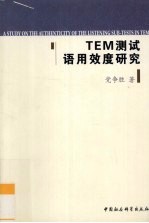
- 作 者:党争胜著
- 出 版 社:北京:中国社会科学出版社
- 出版年份:2008
- ISBN:9787500475521
- 标注页数:240 页
- PDF页数:259 页
请阅读订购服务说明与试读!
订购服务说明
1、本站所有的书默认都是PDF格式,该格式图书只能阅读和打印,不能再次编辑。
2、除分上下册或者多册的情况下,一般PDF页数一定要大于标注页数才建议下单购买。【本资源259 ≥240页】
图书下载及付费说明
1、所有的电子图书为PDF格式,支持电脑、手机、平板等各类电子设备阅读;可以任意拷贝文件到不同的阅读设备里进行阅读。
2、电子图书在提交订单后一般半小时内处理完成,最晚48小时内处理完成。(非工作日购买会延迟)
3、所有的电子图书都是原书直接扫描方式制作而成。
CHAPTER ONE INTRODUCTION 1
1.1 TEM4 and TEM8 in China 1
1.1.1 An overview of TEM4 and TEM8 1
1.1.2 An overview of current listening comprehension parts of TEM4 and TEM8 5
1.1.3 TEM4 and TEM8 listening test validation study 8
1.2 Description of the thesis study 10
1.2.1 Purpose and scope of the study 10
1.2.2 The research questions 11
1.2.3 Study methods 12
1.2.4 Study results 13
1.2.5 Structure of the dissertation 13
CHAPTER TWO LITERATURE REVIEW 16
2.1 Language competence 16
2.1.1 Classical UCH versus MCH 17
2.1.2 Varying definitions of language proficiency 18
2.1.3 The influence of pedagogic approaches on the interpretation of language competence 21
2.1.4 Some recent frameworks of communicative competence 25
2.2 Listening competence 31
2.2.1 Major listening situations and their classifications 31
2.2.2 Listening comprehension as hypothesized processes 34
2.2.3 Buck's framework of listening ability 38
2.3 Two supplementary points about listening comprehension 40
2.3.1 The passive and active natures of listening comprehension 40
2.4 Listening comprehension testing:pre-World War Ⅱ period 47
2.4.1 The three major approaches to language testing 48
2.4.2 Earlier listening comprehension testing in the U.S 50
2.4.3 Earlier listening comprehension testing in the U.K 53
2.5 Listening comprehension testing:post-World War Ⅱ period 55
2.5.1 overseas studies 55
2.5.2 Studies in China 58
2.6 Progress in listening comprehension testing:after the 1980s 61
2.6.1 Progress made in people's knowledge about listening competence 62
2.6.2 A framework for listening comprehension 64
2.6.3 Progress made in theories concerning the effect of test method 66
2.7 Formats of listening comprehension sub-tests in some famous English proficiency tests 68
2.8 Conclusion 68
CHAPTER THREE A TENTATIVE ANALYSIS AND COMMENT ON TEM4 AND TEM8 LISTENING COMPREHENSION TEST PAPERS IN USE 70
3.1 Test authenticity 71
3.2 TEM4 and TEM8 item type analysis 77
3.3 TEM4 and TEM8 listening test content analysis 80
3.4 TEM4 and TEM8 test task analysis 85
3.5 Comments on the test papers in use 89
3.5.1 The positive side of the papers and their beneficial backwash on pedagogy 89
3.5.2 The imperfections of the papers and their detrimental backwash on pedagogy 91
CHAPTER FOUR LISTENINGNEEDS ANALYSIS 94
4.1 Needs analysis 94
4.2 Important listening domains 97
4.3 Real-life listening situations and tasks 103
4.3.1 Varieties of English language 105
4.3.2 The matter of accents 108
4.4 Correspondence between test tasks and real-life listening activities 113
4.4.1 Seeking correspondence between the test taker's psychological state and that of the non-test taker's 116
4.4.2 Seeking correspondence between the test language and the real-life language 121
4.4.3 Seeking correspondence between test tasks and real-life listening activities 123
4.5 Conclusion 125
CHAPTER FIVE REVISED TEST SPECIFICATIONS FOR TEM LISTENING SUB-TESTS 128
5.1 Test Specifications 128
5.2 Original test specifications for TEM4 listening sub-test 130
5.3 Revised test specifications for TEM4 listening sub-test 133
5.4 Original test specifications for TEM8 listening sub-test 139
5.7 Revised test specifications for TEM8 listening sub-test 141
5.6 Conclusion 146
CHAPTER SIX THE EXPERIMENTAL TEST AND THE RESULTS ANALYSIS 148
6.1 Two assumptions to be tested 148
6.2 Construction of the experimental test 150
6.3 Administration of the experimental test 151
6.4 Test results analysis 153
6.4.1 The T test results 153
6.4.2 Facility value and discrimination power analysis 154
6.5 Questionnaire survey 157
6.5.1 Purpose 157
6.5.2 Construction of the questionnaire survey 158
6.5.3 Framework of the questionnaire survey 158
6.6 Conclusion 161
CHAPTER SEVEN CONCLUSIONS AND RECOMM-ENDATIONS 162
7.1 Conclusions 162
7.2 Recommendations for TEM listening sub-tests 165
7.3 Recommendations for the TEM 172
7.4 Suggestions for Writing Listening Test Items 176
Appendix 1.1 Scripts of TEM4-2001 and TEM8-2001 Listening Sub-tests 178
Appendix 2.1 Taxonomies of Listening Skills 197
Appendix 2.2 The Criteria for Listening Comprehension in HSK 205
Appendix 2.3 Major Overseas Listening Comprehension Test Formats 207
Appendix 2.4 Major Domestic Listening Comprehension Test Formats 212
Appendix 4.1 英语专业学生英语听力问卷调查 214
Appendix 4.2 英语专业学生英语听力问卷调查 217
Appendix 6.1 专业英语四级听力考试(实验卷)学生问卷调查表 220
Appendix 6.2 专业英语四级听力考试(实验卷)教师问卷调查表 222
BIBOLIOGRAPHY 224
Table 1.1 Test structure of TEM4-2001 3
Table 1.2 Test structure of TEM8-2001 4
Table 2.1 A framework for describing listening ability 39
Table 2.2 Summary checklist of operations(listening comprehension) 65
Table 2.3 Summary checklist of performance conditions(listening comprehension) 65
Table 3.1 A comparison and contrast among listening abilities required respectively in ETSEMIHL,the TEM syllabi and the TEM-2001 82
Table 3.2 The candidates' questionnaire statistical results 85
Table 4.1 Categorization of listening domains 99
Table 4.2 Categorization of listening situations and tasks 100
Table 4.3 Importance of major listening purposes of English majors 101
Table 4.4 Frequency of occurrence of major listening situations 102
Table 4.5 The informants' opinions/suggestions about/to the current listening sub-tests 103
Table 6.1 The mean score on each section in Test A and Test B 154
Table 6.2 The T test results for the respective sections of Test A and B(one-tailed) 154
Table 6.3 Facility values of item No.5 in Test A and Test B 155
Table 6.4 Facility values of item No.6 in Test A and Test B 155
Table 6.5 Discrimination Index of item No.5 in Test A and Test B 155
Table 6.6 Discrimination Index of item No.6 in Test A and Test B 156
Table 6.7 Facility values of item No.7 in Test A and Test B 156
Table 6.8 Discrimination Index of item No.7 in Test A and Test B 156
Table 6.9 Students' comments on the experimental test 160
Table 6.10 Teachers' comments on the experimental test 160
